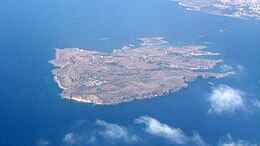Comino
| Native name: Kemmuna | |
|---|---|

Aerial view of Comino
|
|
| Map of Comino | |
| Geography | |
| Location | between Gozo and Malta, south of Sicily, Mediterranean Sea |
| Coordinates | 36°00′40.6″N 14°20′12.5″E / 36.011278°N 14.336806°ECoordinates: 36°00′40.6″N 14°20′12.5″E / 36.011278°N 14.336806°E |
| Archipelago | Maltese Islands |
| Area | 3.5 km2 (1.4 sq mi) |
| Administration | |
| Region | Gozo |
| Local council | Għajnsielem |
| Demographics | |
| Population | 4 |
Comino (Maltese: Kemmuna), formerly called Ephaestia, is a small island of the Maltese archipelago between the islands of Malta and Gozo in the Mediterranean Sea, measuring 3.5 square kilometres (1.4 sq mi) in area. Named after the cumin seed that once flourished in the Maltese islands, Comino is noted for its tranquility and isolation. It has a permanent population of only four residents. One priest and one policeman commute from the nearby island of Gozo, to render their services to the local population and summertime visitors. Today, Comino is a bird sanctuary and nature reserve. Administratively, it is part of the municipality of Għajnsielem, in southeastern Gozo.
The island has a karst landscape supporting sclerophyllous shrubland. Some limited afforestation with pine trees has been carried out. The sand-dunes at Santa Maria bay retain some native vegetation, including Vitex and Tamarix trees. The island has been identified as an Important Bird Area (IBA) by BirdLife International because it supports 50–80 breeding pairs of yelkouan shearwaters.
Comino is known to have been inhabited by farmers during Roman times, but for long periods in its history it has been sparsely populated, privately owned, or abandoned entirely.
Its rugged coastline is delineated by sheer limestone cliffs, and dotted with deep caves which were popular with pirates and marauders in the Middle Ages. The caves and coves of Comino were frequently used as staging posts for raids on hapless boats crossing between Malta and Gozo. In later years, the Knights of Malta used this island as hunting and recreational grounds. The Knights were fiercely protective of the local game, which consisted of wild boar and hares (Maltese: fenek tal-grixti): upon conviction, poachers were liable to a penalty of three years as a galley slave.
...
Wikipedia

